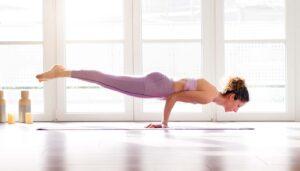Unlocking the Full Potential: Poorna Dhanurasana (Full Bow Pose)
Every asana in the enormous ocean of yoga poses has special advantages and difficulties of its own. One of these is the Poorna Dhanurasana, or Full Bow Pose. This stance is derived from Sanskrit, where “Dhanu” means a bow and “Poorna” means full, entire, or whole. It captures the elegant arch of a fully drawn bow. Even though Poorna Dhanurasana seems exquisite, posture takes patience, practice, and knowledge of its subtleties to master.
Steps to Achieve Full Bow Pose (Poorna Dhanurasana)
Preparation: First, prepare yourself by lying flat on your stomach (prone posture), with your arms resting beside your body and your legs straight.
Bend Your Knees: Maintaining a hip-width distance between your heels and buttocks, bend your knees.
Reach Back: Grab your ankles with your hands as you extend your reach back. Make sure your hands are pointing up.
Inhale and Lift: then raise your chest off the ground as you inhale deeply. Kick both of your legs back and up at the same time to raise your thighs off the ground.
Create the Bow: Feel the strain in your abdomen and chest as you keep lifting. Your body will naturally curve into a bow-like shape.
Gaze Forward: Hold your head straight or cock it slightly to the rear. While keeping your equilibrium, look forward or slightly upward.
Hold and Breathe: Maintain the posture for 15 to 30 seconds while taking regular, deep breaths. To stabilize the arch, maintain the contraction in your back muscles.
Release: As you gently lower your legs and chest back to the floor, exhale slowly to leave the position. Let go of your ankles and lie down to rest.
Benefits of Full Bow Pose (Poorna Dhanurasana)
Strengthens Back Muscles: Poorna Dhanurasana focuses on the back muscles along the spine, which helps to tone and strengthen the back.
Improves Posture: Holding this pose on a regular basis helps to realign rounded shoulders and encourages an upright posture.
Stretches Front Body: The pose’s arching motion stretches the front body’s muscles, particularly the flexors of the hips, chest, and abdomen.
Enhances Flexibility: It promotes a greater range of motion and general flexibility by improving the flexibility of the thighs, shoulders, and spine.
Stimulates Digestion: This pose’s compression of the abdomen helps facilitate digestion and ease tummy pain.
Calms the Mind: By drawing attention to the body and breathing, Poorna Dhanurasana, like many other yoga postures, encourages relaxation and lowers stress levels.
Precautions and Contraindications Of Bow Pose
Back Injuries: Avoid this position or practice under the supervision of a qualified yoga instructor if you have a recent or persistent back injury.
Neck Problems: Refrain from leaning your head back excessively if you are experiencing neck pain or discomfort. Maintain a neutral neck posture.
Pregnancy: Poorna Dhanurasana should not be performed by pregnant women, especially in the later stages of the pregnancy, as this poses an unnecessary strain on the belly.
High Blood Pressure: Take caution when attempting this posture if you have high blood pressure. Make sure your breathing is steady and easy.
Wrist or Ankle Pain: Adjust the pose or use props to support the affected regions if you feel pain in your wrists or ankles.
Read More: Learn Yoga in Rishikesh
It is important to pay attention to your body and develop mindfulness, just like with any other yoga practice. Poorna Dhanurasana can help you reach your best potential on and off the mat by strengthening your physical and mental health with consistent, focused practice.
Learn to know more about yoga and meditaiton so you cah join yoga teacher training in rishikesh and 200 hour yoga teacher training in Rishikesh and yin yoga teacher training in rishikesh and aerial yoga teacher training in rishikesh




